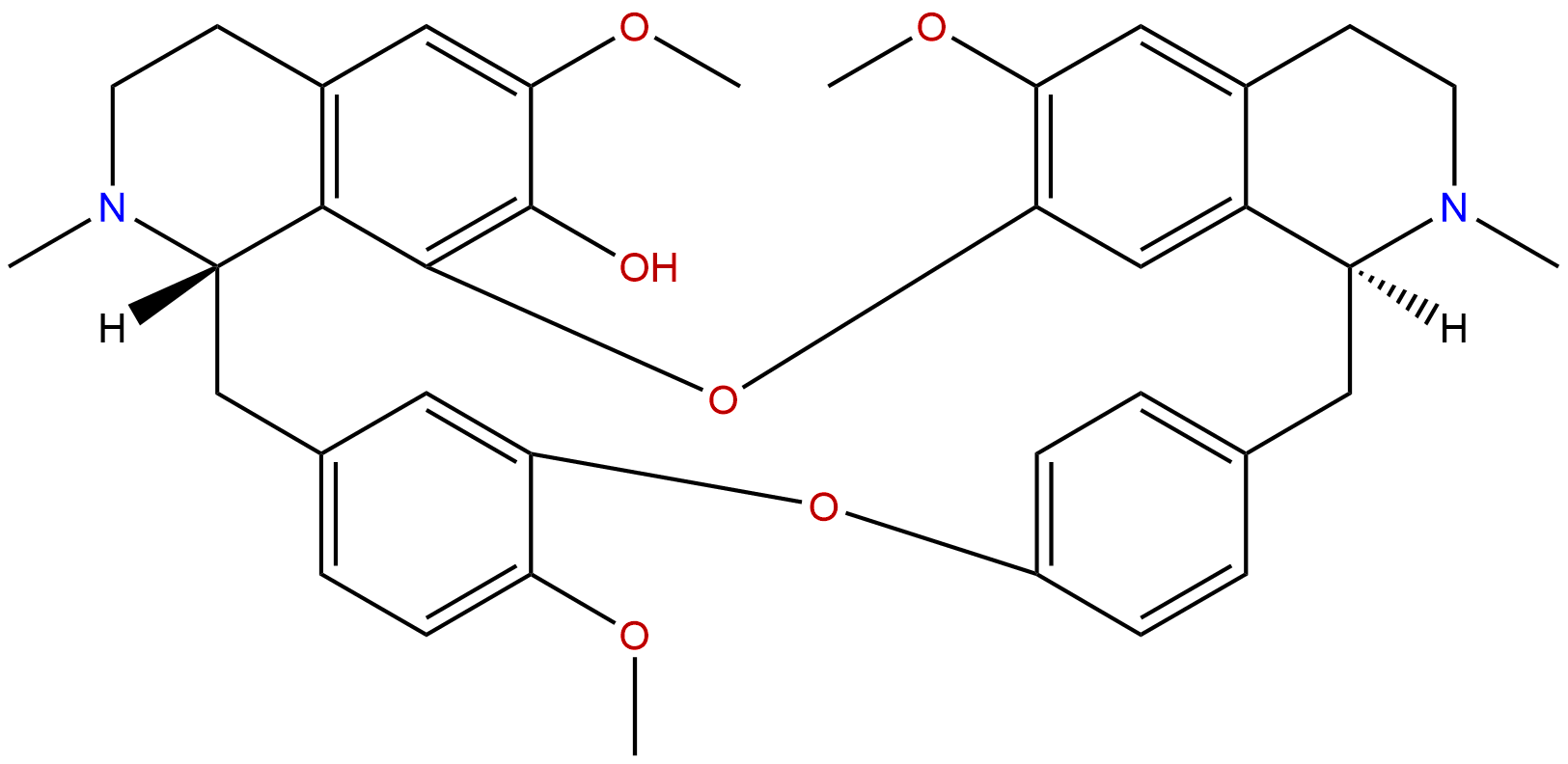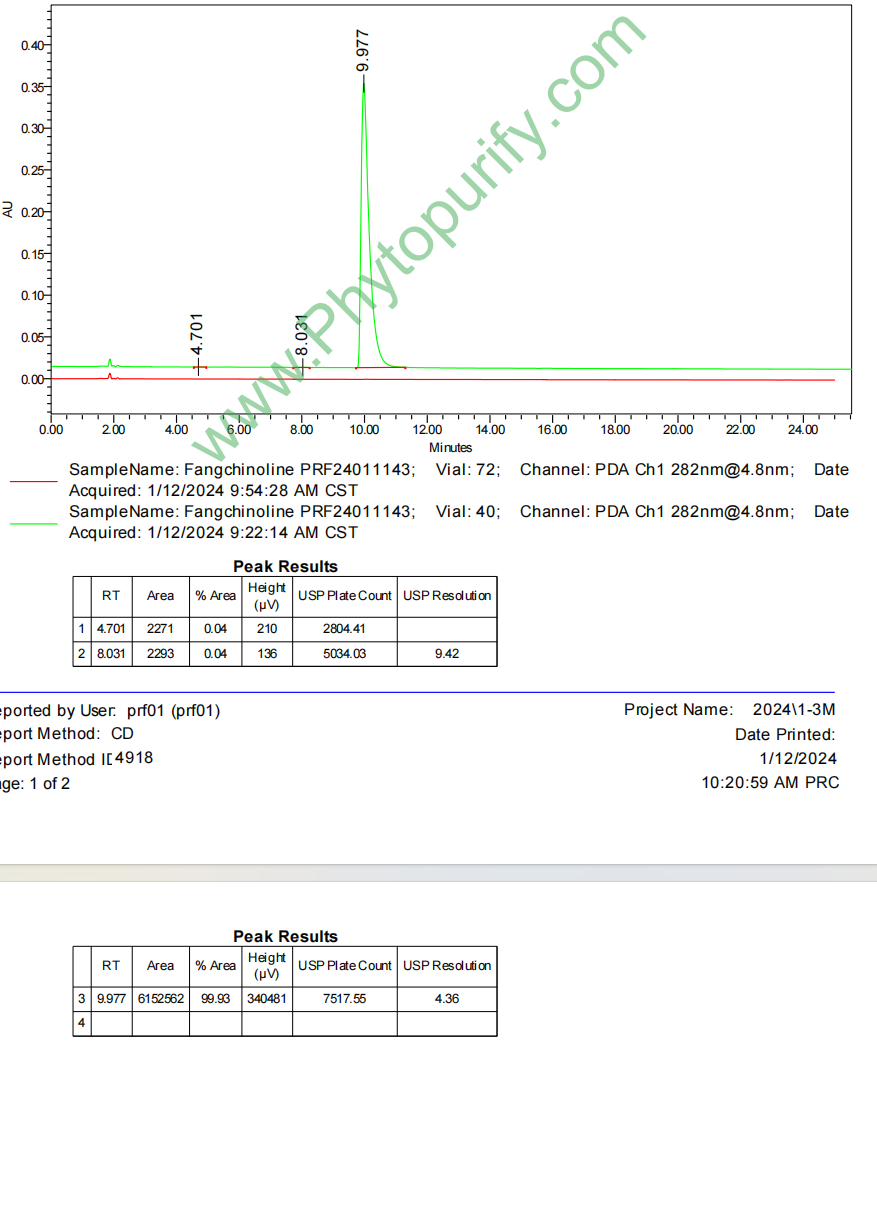
FangchinolineCAS No.:436-77-1 |
||||||||||
 |
|
|
||||||||

| Catalogue No.: | BP0582 |
| Formula: | C37H40N2O6 |
| Mol Weight: | 608.735 |
| Botanical Source: | Stephaniae Tetrandrae Radix |
Product name: Fangchinoline
Synonym name: Hanfangchin B; 12-O-Methylatherospermoline; Menisidine
Catalogue No.: BP0582
Cas No.: 436-77-1
Formula: C37H40N2O6
Mol Weight: 608.735
Botanical Source: Alkaloid from Root of Cyclea peltata, Triclisia subcordata and Stephania hernandifolia, the tubers of Stephania tetrandra, and from the bark of Daphnandra sp. Dt-7 (Menispermaceae, Atherospermacaceae).
Physical Description: Powder
Type of Compound: Alkaloids
Purity: 95%~99%
Analysis Method: HPLC-DAD or/and HPLC-ELSD
Identification Method: Mass, NMR
Packing: Brown vial or HDPE plastic bottle
Storage: Store in a well closed container, protected from air and light. Put into refrigerate or freeze for long term storage.
Whenever possible, you should prepare and use solutions on the same day. However, if you need to make up stock solutions in advance, we recommend that you store the solution as aliquots in tightly sealed vials at -20℃. Generally, these will be useable for up to two weeks.
The product could be supplied from milligrams to grams, up to kilograms
Inquire for bulk scale.
Descriptions:
Fangchinoline and tetrandrine are the major alkaloids from Stephania tetrandrae S. they shows anti-inflammatory effects on mouse ear edema induced by croton oil, the biochemical mechanisms of fangchinoline and tetrandrine on anti-inflammation are significantly different even though they are similar in chemical structure.[1]
Fangchinoline and tetrandrine have vasodilating and hypotensive effects on the rat aorta and the stroke-prone spontaneously hypertensive rat.[2]
Fangchinoline is a highly specific agent inducing autophagic cell death via p53/sestrin2/AMPK signalling in hepatocellular carcinoma cells with a novel mechanism, which elucidates the potential of fangchinoline to potentiate programmed cell death in cancer cells.[3]
Fangchinoline is a nonspecific Ca(2+) channel blocker, it reduces both FBS- and PDGF-BB-induced RASMCs proliferation by perturbing cell cycle progression; this antiproliferative effect of FAN is dependent on the MAP kinase pathway, but cannot be limited to its Ca(2+) modulation.[4]
Fangchinoline (Fan) has anti-tumorigenic activity in vivo, including reduction of tumor volume and pro-apoptotic and anti-proliferative effects in a PC3 nude mouse xenograft, it inhibits human prostate cancer cell lines (PC3) cell proliferation in a dose- and time-dependent manner, the anti-proliferative effect is associated with an increase in the G1/S phase of PC3 cells, suggests that Fan is an effective anti-proliferative agent that modulates cell growth regulators in prostate cancer cells.[5]
Fangchinoline can enhance the cytotoxicity of multidrug resistance-related drugs via modulation of P-glycoprotein.[6]
Fangchinoline has effective antioxidant and radical scavenging activity, also has protective effects on hydrogen peroxide-induced oxidative neuronal cell damage in cultured rat cerebellar granule cells.[7]
Fangchinoline can inhibit human immunodeficiency virus type 1 replication by interfering with gp160 proteolytic processing.[8]
References:
[1] Choi H S, Kim H S, Min K R, et al. J Ethnopharmacol, 2000, 69(2):173-9.
[2] Kim H S, Zhang Y H, Oh K W, et al. J Ethnopharmacol, 1997, 58(2):117-23.
[3] Ning Wang ?, Weidong Pan ?, Zhu M, et al. Brit J Pharmacol, 2011, 164(2b):731–42.
[4] Zhang Y H, Fang L H, Ku B S. Biochem Pharmacol, 2003, 66(9):1853-60.
[5] Choi S U, Park S H, Kim K H, et al. Anti-cancer drugs, 1998, 9(3):255-61.
[6] Wang CD, Huang JG, Gao X, et al.Biosci Biotech Bioch, 2010, 74(3):488-93.
[7] Gül?in I, Elias R, Gepdiremen A, et al. J Enzyme Inhib Med Ch, 2010, 25(25):44-53.
[8] Koh S B, Ban J Y, Lee B Y, et al. Planta Med, 2003, 69(6):506-12.
[9] Wan Z, Lu Y, Liao Q, et al. Plos One, 2012, 7(6):286-286.
Lu X G, Zhang R X, Feng F, et al. J Chromatogr Sci, 2015, 53(8):1-5.
HPLC of Fangchinoline
